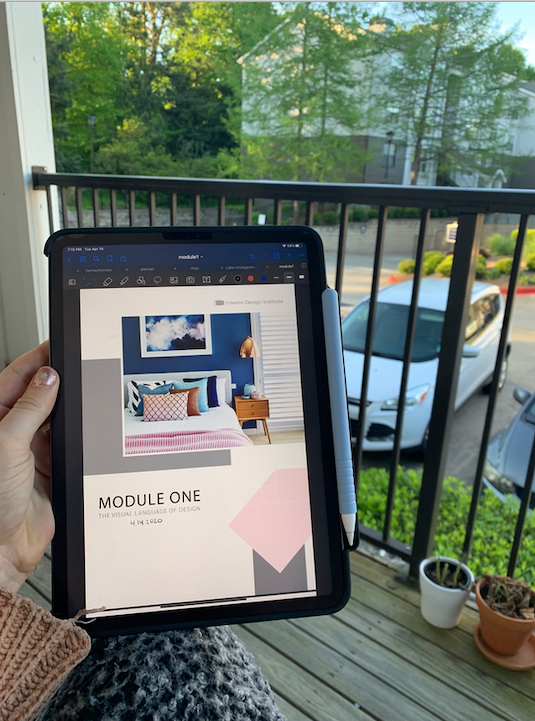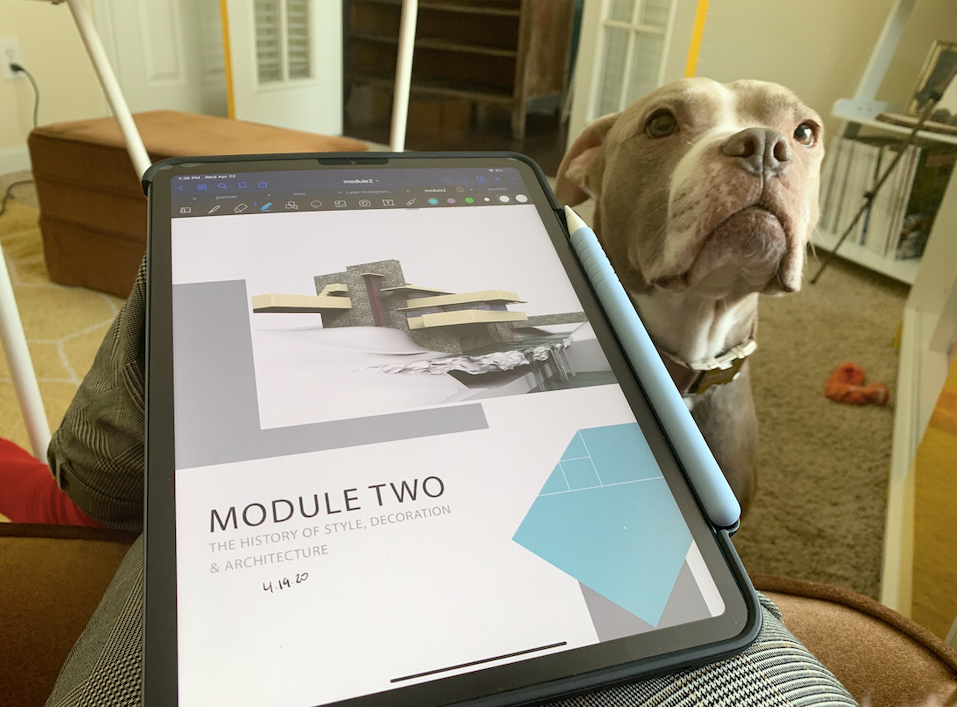You’re gonna be right alongside me as I go through my online certification with The Interior Design Institute. In this first part I cover my decision process, and my review of the first 2 modules.


The Interior Design Institute review: part 1
As someone who already has a Bachelor’s but wanted to invest more in my interior design passion, I was at a crossroads of what to do. Should I go back to school? Or should I find an online program? Since the original writing of this post, I wrote another post to help you decide on that same question. My ultimate decision was to pursue an online certification. And I ended up going with the Interior Design Institute. But not after lots of searching, contemplating, and more searching.
If you find yourself in the same boat and want to hear about my experience, keep reading. Hopefully it will make the path forward clearer for you!
So to begin, I started my (prolonged) search for the right program for me…
the search
Since I already have a bachelor’s degree in communication, a bachelor’s in interior design isn’t in the cards, at least for right now. So online certification classes were the move for me – both in terms of time and money.
My goals with getting this course was to start doing interior design work independently. I knew that I didn’t want to try to get into a big interior design firm, so the 4-year University route didn’t seem quite as necessary.
I had previously taken an 8-week night course at Emory University, a school near me. It gave me a lot of design inspiration, for sure. But there was no certification and I left the class feeling like I had a lot more to learn.
So I was like duhh, lets do an online program.
If you search “online interior design classes” on Google, you will see exactly this:




In other words, a source of anxiety for someone who always wants to make the most well-informed decision possible.
I did know, though, that I wanted to get a certification, and I was willing to pay. I knew that paying would most likely get me more value and there would be more legitimization of the education.
And it would force me to mentally value and prioritize it as well. We all know one of the principles of persuasive psychology 101: you value something more if you buy it versus get it handed to you for free.
the options for online interior design certification programs
After narrowing down my search a little more, there were 2 good online options in front of me. The New York Institute of Art and Design (NYIAD) and The Interior Design Institute (IDI).
Both of them had glowing reviews on their websites, of course, but I really struggled to find a good review elsewhere on the internet.
(And the lack of reviews made me want to write this review to help out all of you who were in the same boat as me!)
One thing I ultimately went off of, though, was that The Interior Design Institute shared who some of their alumni were, along with their IG handles. And I was impressed by the work of the alumni.
That’s really all I had to go off of, so that’s kind of what made my decision mostly.
that, and the price.
NYIAD’s price varies slightly depending on what promotion they’ve got going, but it’s around $800.
IDI comes in at just under $1,000 for the 12 module certification course ($1099 if you break it into payments).
You can also do the course + the Darren Palmer masterclass for $1,399 ($1,499 in payments). And there are tons of advanced modules you can take after for $199 on topics like AutoCAD, commercial design, landscape design, etc.
I decided to go with the slightly more expensive choice, The Interior Design Institute. The website appeared a little more professional, I liked seeing the student’s work, and I was hoping cost would equate to value.
So my decision was made!
The awesome thing was once I already made my decision, I reached out letting them know that I would love to work with them to give the potential interior design students of the internet an in-depth, honest review, and they said let’s do it!
So full transparency, this content is sponsored, but I am going to be absolutely honest about my experience. The whole reason I want to share is because I wanted something like this in my search. It’s just a bonus that I could a lil discount out of it.
And a bonus for you, too. If you hear my experience and feel like this is the right program for you, you can get $200 off your tuition.
how it’s gonna work
You can look forward to three separate blog posts – including this one – about my experience as I’m going through the course.
The first, now, is in the midst of module 2, the next will be at the halfway point, module 6, and the final once I complete the program.
So if you’re here as I’m just starting, make sure you subscribe so you can get notified as soon as I publish the next installment.
There are 12 modules, and I set a goal of one module per week. But, it says that most people finish in 6 months. So I’m thinking my lil week per module plan might be a little optimistic.
We’ll see, though. I do have a full-time job and run this blog (basically a full-time job in itself), so I’m gonna press the brakes as needed.
You have access to the course for a year (with the possibility to extend if needed), so it seems pretty well-suited to be as flexible as you need it to be in terms of time.
oookay, so let’s start!
I think I’m gonna go module by module, then a full wrap-up at the end. I figured this would be the best way for you to hear my opinion and get a feel for the content students get at the same time.


The Interior Design Institute module 1: the visual language of design
This is the introductory module, so there are a few logistical things at the beginning, saying what to expect, how to make the most of the course, etc. Then it has a few sections on what interior design is, the philosophy of design, and understanding design theory.
I’m gonna be honest, when I first started this, I felt a little mehh.
It seemed a little fluffy and like something I could learn by a quick Google. But once you get past the first couple of sections, it gets a little meatier.
Just think of it like syllabus day in class. It’s never that intense on the first day.
The rest of the module dives deep into the Elements of Design and the Principles of Design.
This the more nitty-gritty information I was hoping for. It gets into an overview of the technical aspects of design. For me, this helped to begin to bridge the gap between just having an eye for design and actually knowing wtf you’re doing.
It gives you a basis for the creative decisions you make.
It was introductory, and it looks like most topics will be delved into in later modules. But honestly, it was pretty solid for a first lesson.
the homework
Surprisingly involved.
Half of me was expecting (though not hoping) that the assignment would be a little fluffy, just like a creative project.
But mannn was I wrong.
Maybe it’s just because I’m an absolute perfectionist, but it took me 3 different sittings to knock this assignment out.
You basically apply knowledge from every single element (there are 7) and principle (there are 5) to 3 separate rooms. It really took some focus and cross-referencing with my notes and the example they provided to get through it.
All in all, my assignment added up to around 6 pages typed.
A pretty solid first impression of the first assignment. It was definitely enjoyable, but there’s no denying it took some critical thinking, and critical looking.
The Interior Design Institute module 2: the history of style, decoration and architecture


I LOVED this! It was like a massive history lesson – of design, but also a little bit of society in general.
This module, quite a bit longer than the first, goes through the complete architectural timeline of the world, from the first documented buildings to the present day. It has a slight introduction talking about how architecture is so intertwined with interior design, but the rest goes right into all of the different periods.
Prepare yourself, there’s a lot of information.
I would recommend either downloading the coursework onto a tablet where you can annotate it, or print it out to physically write on it. There’s a shit ton of information, so it’s best to highlight important things so they’re easily accessible after.
One thing I found helpful was to come up with a highlighting scheme.
I did blue for historical information, orange for visual components, and green for important names. I also would sometimes write a shorter, more digestible blurb next to a longer paragraph so it’s easier to access later.
A lot of this is common knowledge and kinda note-taking 101, but I wanted to share that specific plan, because it was very helpful.
Another tip: have Google at the ready.
The module does a good job of giving you lots of information, but sometimes they reference something I’m not aware of. Could be a certain architectural feature that I don’t know, a historical reference that I don’t understand, or a designer I wanna know more about. And it was SUPER helpful to Google it and make note in the module.
Just like a regular class, they give you everything you need to know. But if you wanna go above and beyond, take some initiative and do a little independent research.
Plus, a quick Google of the architectural time period, i.e. “art deco architecture” is helpful as you’re about to start the section to give you some visual background prior to.
the homework
My recommendation: don’t start the homework on the same day you finish the reading.
For me, I finished reading through the material, the next day reviewed it and make a couple of pages of notes, then the next day started the homework assignment. You have the time, so don’t burn yourself out by cramming everything together.
But that’s my personal opinion, so if you wanna do it while it’s fresh, by all means.
This assignment is a little less intense than the last, because it’s more focused and less broad. What you’re tasked with is taking 5 buildings from different architectural styles and going through the different characteristics through the lens of that style.
Maybe it’s just because I went hard on the notes here, but this was pretty easy for me. It wasn’t mindless by any means, but I felt super equipped to make the interpretations I did as a result of the module and outside research.
Also, the example assignment is extremely helpful in giving you some structure to your answers. Try not to rely on them too much, but use it as a guide if you’re stuck. And do a conformity check once you’re all done to make sure you’re not super far off base.
overall first impressions
Very pleasantly surprised!
I was honestly very skeptical that there would be some lack of validity to the program since it’s online. And I also went in a lot cockier that I would know most things already. Luckily, I was wrong. This shit is pretty legit.
Am I getting a university-level education? Probably not. But do I feel like I’m gaining a lot of valuable knowledge that I’m already looking forward to implementing in my own home, blog posts, and hopefully clients soon? Absolutely.
I think that my natural interest in design and my (I’d like to think) eye for design are very helpful as I go through the course, and it might take a little more oomph and initiative in doing outside research to get through it as a total newbie to the field.
But then again, I think most people who want to take this have a pretty good base knowledge.
I’ve found it super helpful, and more fun than usual, to look through Pinterest and magazines and blogs through the lens of what I’m learning. It helps me exercise those muscles, and it’s just straight-up interesting. And I’m assuming it will only increase as I go through the course.
Final thoughts: I’m excited to move on further through the process, and The Interior Design Institute seems worth it to me so far.
Again, make sure you’re subscribed so you’ll be notified when I post the next update! At the current pace, you can expect it in about 4 weeks. Maybe sooner, maybe later. No promises on the timeline 😉
keep it homey, homies
About me
Hey my name’s Hannah Michelle Lambert, the voice behind homey homies. I’m an LA-based designer, writer, and content strategist. I’m passionate about the intersection of productivity and creativity. I love talking about creative habits, technology, processes, and everything in between that helps me blend the Type A and Type B parts of my brain.






Hi Hannah!
I’m so sad I crossed into your page and read your reviews that actually motivated me to get enrolled to the course at IDI, but I totally missed out the perks of getting 200 dollars fees off! It was after I purchased and decided to came back to check this page again and I realized what I missed. 😔 Anyway, I enjoyed your writings and it is very helpful reviews!
Ah man, it may be worth reaching out to them to let them know what happened! I have a direct contact there if you want it via email. They’re really nice people and there’s a possibility they may apply the discount retroactively. Shoot me an email a hannah@homeyhomies.com and I’ll give you their contact info! 🙂
But I’m so glad my posts were helpful! Good luck going through the modules!